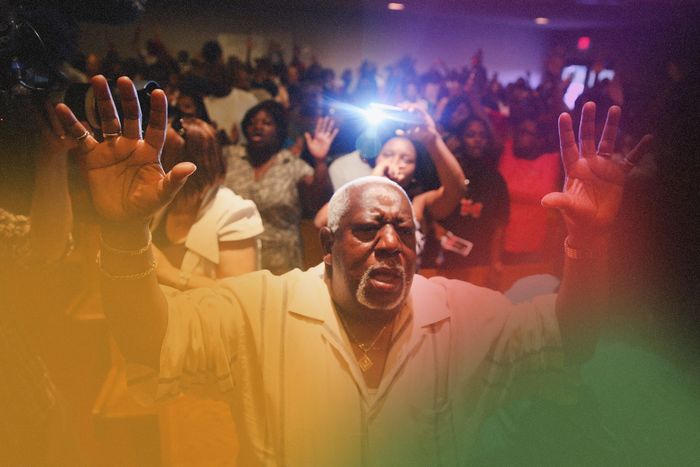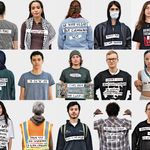
“This ain’t your grandparents’ civil-rights movement!” Rapper Tef Poe yelled from the stage of the Chaifetz Arena in St. Louis on October 12, 2014. Several of us stood in solidarity and turned our backs on the religious leaders who organized the rally in the wake of Michael Brown’s killing at the hands of white police officer Darren Wilson in Ferguson, Missouri. The Black church, once the moral compass of African American politics, would not lead this new generation of protest.
But the exodus from church is not a flight from faith. It is an escape from the bondage of patriarchy, queer-antagonism, and respectability politics that have long plagued the religious terrain. Activists are embracing other pathways through the wilderness of racial oppression. “We are leaving in search of a practice[s] that is overtly inclusive of our sexuality, ancestral practices, and race,” Meagan Jordan wrote for the Black Youth Project. “While we may not be going to church in the traditional sense, we are gathering together in unique spaces.”
Jordan invites us to question the question: Where is the church in Black Lives Matter? What if, in our search for the church, we miss the spirit erupting beyond its walls?
On August 9, 2014, just hours after Mike Brown’s killing in Ferguson, Missouri, local residents adorned the stretch of Canfield Drive where the teenager’s lifeless body lay face down for over four hours. Many brought flowers, candles, teddy bears, balloons, cards, and photographs. Some poured out liquor and placed the empty bottles between bouquets and baseball caps. Others paid their respects with prayer or a moment of silence.
As protests exploded across the country, the makeshift memorial blossomed into a beloved community. Activists planted signs that read “Hands Up Don’t Shoot” and “End Police Brutality!” Vigils around the shrine sparked actions across the city. Mourners stood silently for four and a half minutes to symbolize the four and a half hours that the police left Mike’s bleeding body on the street, baking in the summer sun. Mothers wept. Healers burned sage. Protesters formed circles, joined hands, and chanted “Black lives matter” and “Mike Brown means we got to fight back!”
The street memorial was a sacred place of political struggle. And it embodied the spiritual life of contemporary activism.
Black Lives Matter is spiritually promiscuous. It embraces a range of rituals: ancestral worship, call-and-response, chanting, libation, prayer, mysticism, the lighting of incense. Each does its own work. Chanting releases rage. Prayer offers comfort. Magic possesses the dispossessed with faith in the miraculous. Call-and-response turns a Lil Boosie song into a movement anthem. Libation transforms Hennessy into holy water. And all articulate a refusal to give death the last word. It is a makeshift spiritual practice rooted in a love of justice and a reverence for the sanctity of Black lives.
In Toni Morrison’s novel Beloved, a stunning scene unfolds when a community of freedmen and former slaves assembles in the woods. After a moment of prayer, Baby Suggs slams her stick on the ground and beckons everyone to let loose. A frenzy ensues. Children laugh. Men dance. Women wail. And, before long, their twisting hips and roaring laughter and salty tears melt into an ecstatic choreography of praise and protest. After the earth settles, Baby Suggs — the 70-year-old “unchurched” preacher — addresses the multitude who, every Saturday afternoon, carry their scarred backs and calloused hands into the clearing. “Here,’ she said, ‘in this here place, we flesh; flesh that weeps, laughs; flesh that dances on bare feet in grass. Love it. Love it hard.”
The sermon is short and the message is clear: Only love can save us.
The ring shout, as Morrison masterfully depicts it, is among the earliest forms of African American resistance. A remix of African religions and Black Christianity, the “shout!” was a spiritual triumph where enslaved and free Blacks stole away in back woods and danced counterclockwise, as the ring leader’s voice thundered into the night and the group’s collective voice hollered back. Facing the evil of chattel slavery, without redress from the courts or access to the classroom, Black folk created religious rituals to seek solace, honor ancestors, assert a sense of self-regard, and dream of better days.
The ring shout was a circle of life drawn from the shadows of death.
The ritual faded as Black religion in America formalized. But its essential elements echo throughout African American music, dance, religion, and activism. Just spin the records of Sarah Vaughan, John Coltrane, Sun Ra, Billie Holiday, Lauryn Hill, Kendrick Lamar, and Young Thug, and you’ll hear the rhapsodic sorrow of the blues, the improvisational genius of jazz, the supreme virtuosity of hip-hop, and a trap rapper mumbling his way through the tradition. Or attend Sunday service at a Black church and glimpse the Holy Ghost enchanting the feet of elders as the preacher cries out for a witness. Or join a protest against racial violence and let the shout ring through your body.
This is my testimony. In the middle of Canfield Drive, standing at Mike’s memorial, I got lost in the ring. As protesters chanted and loved ones lit candles and strangers became comrades and a community gathered to mourn and rebel, I was possessed with the spirit of freedom and the truth that another world is possible. And, as Baby Suggs demanded, I loved it. I loved it hard.
Ferguson exploded two months after I graduated from seminary, and I felt called to do something. Following the legacy of the 1961 Freedom Rides to challenge racial segregation, activists Darnell Moore, Patrisse Cullors, and others organized Black Life Matters Freedom Rides from over 12 cities to help turn a local rebellion into a national movement. Eager to turn up, I got on a bus from New York City to St. Louis. Twenty-one hours later, 42 of us arrived at St. John’s United Church of Christ.
We used the sanctuary to conduct teach-ins, strategize campaigns, and prepare for acts of civil disobedience. Several of us slept in the basement where we shared stories of what brought us to Ferguson. Perhaps owing to the setting, some protesters talked about their experiences in church. Many of us had been harmed by pastors and parishioners that professed to love all of God’s children. We knew that a place of refuge for some could be a site of repression for others. And that Black liberation not only requires protesting police violence in the streets and systemic racism throughout society. It means confronting the violence of policing women, queer people, and Black youth in the church and throughout our communities.
For decades, Black preachers have sought to redeem the soul of the country. A new generation of activists is reckoning with the soul of the church. And herein lies the spiritual force of the movement. It calls us to confront the ways we have sinned against each other as we protest the ways others have sinned against us. The need for actions, campaigns, and policy changes — while vital for the success of social movements — can eclipse the need for what the Reverend Dr. Martin Luther King Jr. called a revolution of values. As important as politics may be: An ethic of love guides us to our North Star.
This is what connects Baby Suggs to Black Lives Matter. Beyond calls to transform a loveless society, both demand that we embody a love that will transform each other. The two make a road we can all travel. To change the world we must remake ourselves and to change ourselves we must remake the world. This is hard work. Most of us will fall short. But if we journey together, we can reach heights even in the valley of death.
I stopped by the memorial before we left Ferguson. The heat was merciless. I imagined Big Mike’s body sprawled in the street, blood dripping from his head, as neighbors watched in horror. I thought about Lezley McSpadden, who will spend her holidays grieving her most precious gift. I mourned the days Mike will not see and the secrets he will never have the chance to share.
And as the sun rose and my heart sank into my chest, a small crowd began to assemble. A few people lit candles. Some replaced soiled teddy bears and handed out water, while others stood in silence. Many of us wept. And after a few moments, we all joined hands and formed a circle around the shrine. Children, elders, parents, protesters, clergy, residents, out-of-towners, queer organizers, white activists, Black kids from the neighborhood. It felt like an altar call. Except salvation was not about joining a church or having faith in a higher power. It was about believing that every life is holy and joining a movement that protects the living while mourning the dead.




